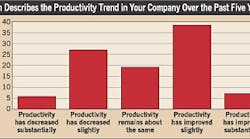A recent survey reveals that less than half of construction companies consider themselves productive. FMI recently surveyed general contractors and subcontractors with annual revenues from $15 million to more than $100 million for its “2004 — 2005 Contractor Productivity Survey,” and while the survey's results identified several positive trends in construction industry productivity, they also revealed that 53% of the companies reported that their productivity had been flat or had decreased over the past five years.
Not only that, 81% of those surveyed said they could save more than 5% of their annual field labor costs through better management of productivity. Scott Kimpland, an FMI director and author of the report, offered an explanation for the industry's bleak productivity outlook. “It seems that the industry has a belief that they can save their way to prosperity,” he says. “That particular mindset might explain why our industry has not been able to change overall performance significantly.” The use of best practices seems to create the difference between companies that reported significant productivity improvement over the past five years and those that have had poor productivity trends. For example, of those companies that had high productivity improvement, 64% thought their project managers were doing a great job compared to only 26% for all respondents. One of the positive trends indicated in this year's survey results was an increase in the use of pre-job planning. FMI's 2003 survey found that only 33% indicated that they had a formal and consistent pre-job planning process, while the latest report shows that 47% of respondents engage in a formal pre-job planning process.



